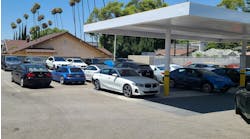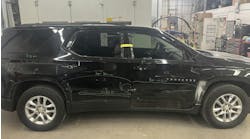Auto Body World is the inaugural winner of ABRN's Top Shops contest
David Fait and his brother Larry renamed the business Auto Body World in 1987. In 2009, Larry Fait retired from the business, creating an opening for a succession ownership team, which now is in place. Last year, Auto Body World generated $23.7 million in revenue by repairing on average 190 vehicles per week with an average repair ticket of about $2,400.
So how did Auto Body World win the 2009 ABRN top honor? The answer is a bit complicated. After weeks of evaluation and a thorough review, Auto Body World claimed the top spot based largely on two factors.First, it consistently stood shoulder to shoulder with the other nine Top Shops finalists named to the contest's top 10, exhibiting excellence and commitment to the industry's best-regarded practices in a number of areas. Each of the top 10 shops demonstrated varying degrees of excellence in each judging category. Auto Body World either topped or tied the highest scores in each area.
Second, the shop distinguished itself by creating a one-of-a-kind lean production process – a process it calls the Rapid Production Model (RPM), which it has used to thoroughly revamp and improve all aspects of its operations. Perhaps most significant, Auto Body World was able to develop a consistent and replicable process capable of being implemented, managed and continuously improved across multiple locations.
Best of the best
Before going into detail on how RPM carried Auto Body World to the top of the industry, let's look at how the shop faired elsewhere in the contest. Because RPM integrates contest-judging categories such as business, employee and customer service philosophies, as well as management procedures, those categories will be described later.The shop is equally involved with its community. Through the National Auto Body Council, it contributes to Recycled Rides, which repairs and donates vehicles to families in need. It raises money for Sunshine Angels, providing shoes and toys for children placed by Child Protective Services, sponsors fund-raisers for the Phoenix Children's Hospital, and along with industry partners, hosts golf tournaments for charities such as the Real Gift Foundation, which serves Arizona's homeless children.
As for innovative marketing programs, Auto Body World soon will be introducing Wrex and Whoopsie, a duo of crash test dummies who will promote safety and quality-conscious repair. See sidebar.'Burning the ships'
According to CEO David Fait, Auto Body World began its search for a revolutionary process model several years ago. "We knew the industry was changing. The old way of doing business wasn't going to work anymore," says Fait.Early on, Auto Body World tried implementing new processes such as repair planning and better parts management. But like most of the industry, it couldn't find a sustainable process. Fait says they continued their search by traveling around the country to visit various other successful businesses, both inside and outside of the collision industry, to study their process models. They also studied lean processing through the W.P. Carey School of Business at Arizona State University.
They eventually reached a key decision. Fait and his team realized that they needed to rethink, to redesign everything. A model that simply improved on their existing business model would not be enough. Fait explains, "We treated it with a 'burn the ships' mentality. We had to let go of our old ways of thinking. We decided we had to design something end-to-end so that all the processes would support one another."They also decided they needed to leverage the principles of lean. Fait says he and several other Auto Body World executives essentially "locked themselves in a room for two months" to design their new process. The result was RPM.
Central to RPM is a continually improving 11-step repair process. Fait says the goal of the 11 steps is to "simplify, simplify, simplify." Shop operations are continually analyzed and refined to ensure they are as transparent and easy to understand as possible. The goal is to get each employee within the company involved in the process so that each understands his or her place within the process.RPM uses small teams of people, called cells, to perform repairs. Cells consist of estimators, body techs, painters and other staff members. Each Auto Body World location (with the exception of one) utilizes several cells, typically two. They are uniform in makeup and roles across the company to maintain consistency, and they are self replicating. One benefit here is that in the event a member of one cell has to miss work, a member of another cell can step in with no disruption of work. Each cell has specific key performance indicator (KPI) goals.
Within the cells, RPM operates with a self-managed, team-driven model that is specific, down to every detail. "Self-management is very important because, as part of RPM, the shop must empower employees with the authority to improve the process," says Mark Turner, president of Auto Body World. "Any employee can stop the process at any point to discuss a problem and suggest ways to improve it."Managers don't oversee every part of RPM like they might in a traditional repair process. The system itself, powered by the team, manages the process. The process uses specific hand off points where work is audited and "pulled" upstream. Employees control these points and decide when work is ready to be passed on. "We don't have checkers checking the checkers," says Fait. "That's simply waste in the system."
Making it work
Implementing RPM involved overhauling practically every part of Auto Body World's operations. The shop completely redesigned its accounting, financial and information technology network and processes. This included a move onto a new innovative management software system called NEXconnex, developed and supported by Nexsyis Collision, which includes a fully integrated accounting system. Their technology, too, became focused on simplicity and transparency. Automated systems now deliver real-time cell-level comparison reporting of KPI performance to the teams on the floor.Leveraging KPI numbers became an important tool in RPM implementation. After Auto Body World developed RPM, it implemented the model in phases at one location. Fait says employees at that location quickly bought into the concept as they heard positive reports from those in the previous phases. Auto Body World's locations always had been highly competitive with one another, and so they keenly watched each other's KPI data.
Turner says that once the KPIs of the original RPM location became known (the location began producing the company's best production numbers), the other locations began clamoring for it and quickly bought into the concept. "It really helped us because they saw it was working," he says.
Team compensation also is a key to supporting RPM. In 2008, Auto Body World developed a single, standard team-based compensation model that is now used across the organization. "It's the fuel for the RPM model. It has created a team-centric environment where the needs and motivations the RPM team members become incredibly aligned – all around the needs of our customers," says Fait. "Because ultimately, RPM is all about the customer."Fait also credits the shop's top insurance partners. He says they too were looking for better processes and supported the shop's implementation of RPM. In fact, he says their support played a big part in RPM's overall success.
In the details
Auto Body World began implementing RPM nearly four years ago. While the business has continually improved RPM as it worked out the details of the process, Fait points to an interesting fact about the model. "The basic concept has not changed much at all. The fundamentals remain the same. The smaller details are always changing as employees look for ways to improve the model," he says.
Continuous improvement is central to RPM. It is designed to be constantly under construction. Fait says the business has adopted the policy that regardless how well RPM is working, it always can be improved. Employees operate under the notion that there's always a better way to do their jobs.
That philosophy has paid big dividends as employees have made some of the largest contributions to the ongoing design of RPM. "Some of the best ideas come from the floor," Fait says.
Looking back at the work and efforts that created RPM, Fait sees some lessons that other shops could benefit from as they look to build their own processes.
"The concepts of what we're doing here aren't much different than what other people are envisioning – with repair planning, receiving the right parts, doing a thorough repair," Fait says. "As an industry, we know what we have to do. The hard part is determining the details of how you tie all these things together into finite steps that people can follow in a methodical way.
"The hard work is building this fixed process where everything upstream affects everything downstream, and the hard part is doing the mental work of figuring out the best possible path, so that nothing stops you from performing that task," he adds.
More difficult still and the key to the creation of any working process for any business is simply finding time to sit down, take time away from the daily tasks involved with running a shop and construct a better process. "The companies that figure out how to do this will be the ones that move forward," says Fait.
As for the future of Auto Body World and RPM, expect both to continue to evolve and get better. Current projects include building an integrated recruiting and training program to support RPM. Ongoing change has been and will remain central to their business model's success.
"We look at it this way," says Fait, "We can still take this a lot further than we are today."



